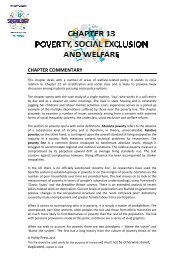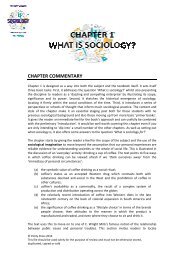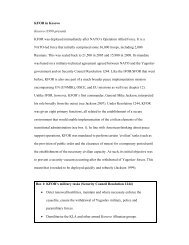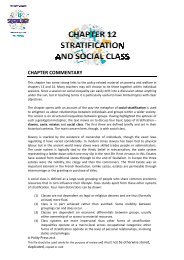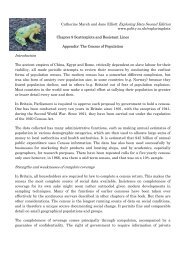Chapter 21 - Crime and Deviance - Polity
Chapter 21 - Crime and Deviance - Polity
Chapter 21 - Crime and Deviance - Polity
Create successful ePaper yourself
Turn your PDF publications into a flip-book with our unique Google optimized e-Paper software.
<strong>Crime</strong> <strong>and</strong> <strong>Deviance</strong><br />
The section ‘Prisons <strong>and</strong> punishment’ points to the tensions which create a situation<br />
where the prison population in the UK is growing <strong>and</strong> is significantly higher as a<br />
proportion of the population than other European countries, despite evidence which<br />
strongly suggests that prison is not a rehabilitative or deterrent force <strong>and</strong> may, in fact,<br />
contribute to hardening the criminality of inmates. Read that section now <strong>and</strong> pay<br />
particular attention to the case of Adam Rickwood (pages 956-7).<br />
Barry Goldson conducted research over a 12-month period in 2001 <strong>and</strong> 2002<br />
into young people (he prefers the term ‘children’) held in locked institutions.<br />
Locked institutions take two different forms: Secure Units, run by local<br />
authorities <strong>and</strong> the Department of Health, where young people deemed to be<br />
‘at risk’ can be placed; <strong>and</strong> Young Offender Institutions, managed by the prison<br />
service <strong>and</strong> the Home Office, which hold young people charged or convicted<br />
with criminal offences. In fact, the backgrounds <strong>and</strong> circumstances of the young<br />
people in these two types of institution share much in common. The extract<br />
below refers specifically to Young Offender Institutions. Some children<br />
interviewed for the study reported negative treatment from the prison staff.<br />
Even if prison staff were willing to meet the inmates’ needs, Goldson found that<br />
understaffing meant that in practice staff were unable to give them appropriate<br />
care. For Goldson, the consequences of such neglect for children are apparent:<br />
It hurts all the time. All you do is miss your family <strong>and</strong> you can’t hack it<br />
sometimes. I wouldn’t send kids to a place like this. (Boy, 16 years)<br />
I felt very lonely <strong>and</strong> that, very lonely really. You are on your own <strong>and</strong> there<br />
is no one to talk to. All you can do is think <strong>and</strong> it really winds you up. I had<br />
no one to speak to <strong>and</strong> it all built-up <strong>and</strong> I started thinking that I can’t take<br />
anymore. (Boy, 16 years)<br />
Worse still, young offender institutions are not just neglectful, they are sites of<br />
concentrated bullying in all its forms – physical assault, sexual assault, verbal<br />
abuse, racist abuse ad assault, intimidation, extortion <strong>and</strong> theft. Prison staff<br />
explain:<br />
It comes in waves, it depends who’s on the wing. You get kids bullying each<br />
other, you get staff bullying kids <strong>and</strong> you get staff bullying staff. … Outside<br />
the kids can get status in lots of ways. In here status is measured in<br />
different ways: fear <strong>and</strong> respect become very confused. (Female prison<br />
officer)<br />
I think that it occurs all the time in different ways. … Especially with verbal<br />
bullying, or just an attitude which is a form of bullying, people don’t always<br />
see it, particularly staff I would say. They call it discipline but it’s really<br />
bullying, it’s an abuse of power. (Male prison nurse)<br />
In other settings such behaviour would be called child abuse.<br />
(Barry Goldson, ‘Victims or threats? Children, care <strong>and</strong> control’, in Janet Fink (ed.),<br />
Care: Personal Lives <strong>and</strong> Social Policy, Bristol: The Policy Press in association with<br />
the Open University, 2004, pp. 103–4)<br />
189





